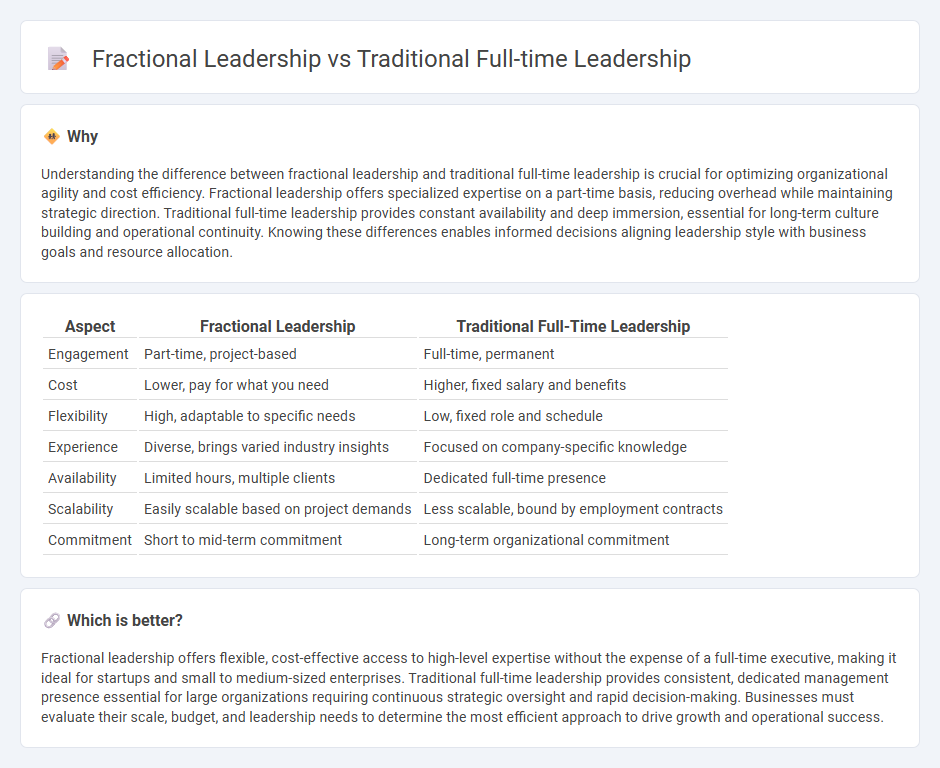
Fractional leadership offers companies access to experienced executives on a part-time basis, optimizing costs while maintaining strategic oversight. Traditional full-time leadership involves dedicated, in-house managers who lead operations continuously but often at higher expenses. Discover how fractional leadership can transform your management approach and improve organizational agility.
Why it is important
Understanding the difference between fractional leadership and traditional full-time leadership is crucial for optimizing organizational agility and cost efficiency. Fractional leadership offers specialized expertise on a part-time basis, reducing overhead while maintaining strategic direction. Traditional full-time leadership provides constant availability and deep immersion, essential for long-term culture building and operational continuity. Knowing these differences enables informed decisions aligning leadership style with business goals and resource allocation.
Comparison Table
| Aspect | Fractional Leadership | Traditional Full-Time Leadership |
|---|---|---|
| Engagement | Part-time, project-based | Full-time, permanent |
| Cost | Lower, pay for what you need | Higher, fixed salary and benefits |
| Flexibility | High, adaptable to specific needs | Low, fixed role and schedule |
| Experience | Diverse, brings varied industry insights | Focused on company-specific knowledge |
| Availability | Limited hours, multiple clients | Dedicated full-time presence |
| Scalability | Easily scalable based on project demands | Less scalable, bound by employment contracts |
| Commitment | Short to mid-term commitment | Long-term organizational commitment |
Which is better?
Fractional leadership offers flexible, cost-effective access to high-level expertise without the expense of a full-time executive, making it ideal for startups and small to medium-sized enterprises. Traditional full-time leadership provides consistent, dedicated management presence essential for large organizations requiring continuous strategic oversight and rapid decision-making. Businesses must evaluate their scale, budget, and leadership needs to determine the most efficient approach to drive growth and operational success.
Connection
Fractional leadership and traditional full-time leadership are connected through their shared goal of driving organizational success by providing strategic direction and management expertise. Fractional leaders offer high-level leadership on a part-time or project basis, complementing or filling gaps within traditional full-time leadership structures. This hybrid approach allows businesses to optimize leadership resources, reduce costs, and maintain flexibility while ensuring continuous operational guidance and decision-making.
Key Terms
Commitment (Full-time)
Traditional full-time leadership demands unwavering commitment, requiring leaders to dedicate their entire professional focus to a single organization's strategic goals and daily operations. This model fosters deep institutional knowledge and consistent availability, which can drive long-term growth and cultural alignment. Discover why full-time commitment remains crucial for organizational stability and sustained success.
Flexibility (Fractional)
Fractional leadership offers unparalleled flexibility by allowing organizations to engage experienced executives on a part-time or project basis, reducing overhead costs and adapting quickly to changing business needs. This model enables companies to access high-level expertise without long-term commitments typically required in traditional full-time leadership roles. Explore how fractional leadership can transform your management strategy with adaptable and cost-effective solutions.
Resource Allocation
Traditional full-time leadership often requires significant budget allocation for salaries, benefits, and training, which can limit flexibility in resource management. Fractional leadership provides access to high-level expertise on a scalable basis, optimizing resource allocation by matching leadership capacity directly to project needs or company growth phases. Discover how fractional leadership can enhance operational efficiency and adapt resource expenditure to your business demands.
Source and External Links
The Leadership Paradigm in Corporate Culture - Traditional full-time leadership is characterized by a hierarchical structure with authority flowing top-down, clear chain of command, formalized communication, well-defined roles, and a focus on stability, efficiency, and established processes.
A guide to traditional leadership vs. servant leadership - Indeed - Traditional leaders usually gain their role automatically, often through inheritance or succession, focusing on business growth and operating as the sole authority distinct from others.
Human leader vs. traditional boss: What's the difference? - Insperity - Traditional bosses exhibit formal, distant relationships with employees, emphasize process and metrics, maintain a business-first mindset, and hold power through rank, control over workload, and authority.
 dowidth.com
dowidth.com